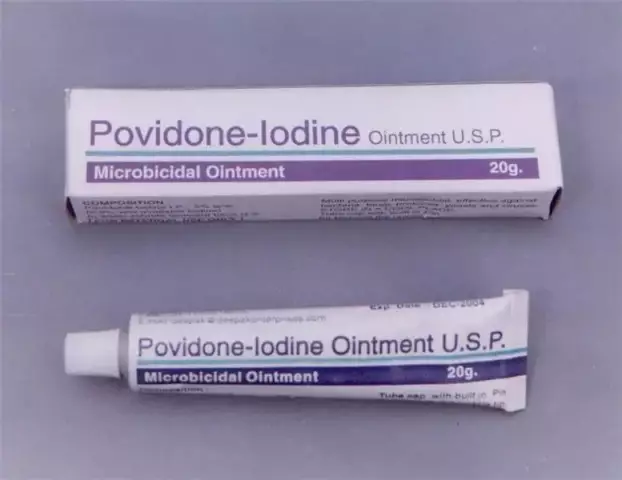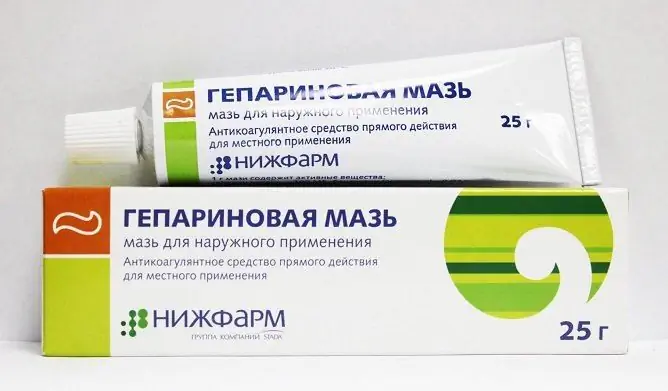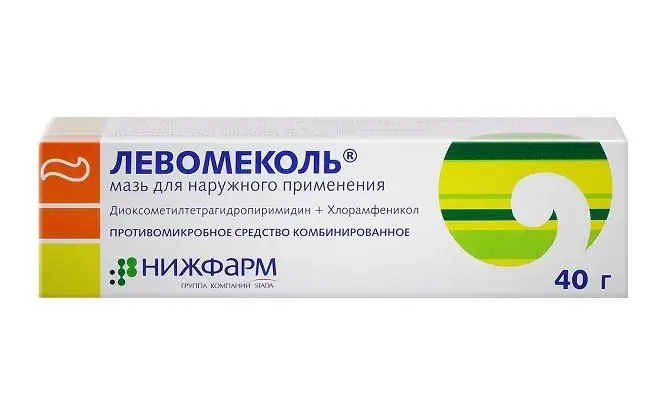- Author Rachel Wainwright [email protected].
- Public 2023-12-15 07:39.
- Last modified 2025-11-02 20:14.
Pantoderm
Pantoderm: instructions for use and reviews
- 1. Release form and composition
- 2. Pharmacological properties
- 3. Indications for use
- 4. Contraindications
- 5. Method of application and dosage
- 6. Side effects
- 7. Overdose
- 8. Special instructions
- 9. Application during pregnancy and lactation
- 10. Use in childhood
- 11. Drug interactions
- 12. Analogs
- 13. Terms and conditions of storage
- 14. Terms of dispensing from pharmacies
- 15. Reviews
- 16. Price in pharmacies
Latin name: Pantoderm
ATX code: D03AX03
Active ingredient: Dexpanthenol (Dexpanthenol)
Producer: Chemical-Pharmaceutical Plant AKRIKHIN, JSC (Russia)
Description and photo update: 2019-12-08
Prices in pharmacies: from 150 rubles.
Buy

Pantoderm is a drug for external use that stimulates tissue regeneration and trophism.
Release form and composition
Dosage form - ointment for external use 5%: with a specific odor, from light yellow to white with a yellow tinge (30 g each in an aluminum tube, in a cardboard box 1 tube).
The active ingredient is dexpanthenol, in 100 g of ointment - 5 g.
Auxiliary components: liquid paraffin, petrolatum, almond oil (almond oil), lanolin, lanolin alcohol, cetostearyl alcohol (40% stearyl alcohol, 60% cetyl alcohol), white beeswax, purified water.
Pharmacological properties
Pharmacodynamics
In the body, the active substance of the ointment, dexpanthenol, is converted into pantothenic acid (an active metabolite). It is a component of coenzyme A, which catalyzes acetylation processes in the body, and also participates in almost all metabolic processes (metabolism of fats, proteins, carbohydrates, phospholipids and fatty acids, the tricarboxylic acid cycle, etc.). Pantothenic acid is involved in the synthesis of corticosteroids and choline acetylation. It accelerates mitosis, stimulates the regeneration of mucous membranes and skin, and increases the strength of collagen fibers.
The action of pantothenic acid is weak anti-inflammatory, metabolic and regenerative.
Pharmacokinetics
When applied topically, Pantoderm ointment is quickly absorbed by the skin, where it turns into pantothenic acid. Pantothenic acid binds to plasma proteins (mainly albumin and beta globulin). Its concentration in blood is 0.5-1 mg / l, and in blood serum - about 0.1 mg / l. In the body, pantothenic acid is not metabolized (with the exception of being a part of coenzyme A). It is excreted from the body unchanged.
Indications for use
- Abscesses, boils;
- Bullous dermatitis;
- Bedsores, trophic ulcers of the leg;
- Minor traumatic and thermal skin injuries (including sunburn), abrasions, cracks;
- Prevention and treatment of inflammation and cracks in the nipples of the mammary gland during breastfeeding;
- Postoperative aseptic wounds, poorly healing skin grafts;
- Dry skin;
- Prevention and treatment of diaper rash in infants.
Contraindications
Individual intolerance to the components of the ointment.
Instructions for use Pantoderm: method and dosage
Pantoderm ointment is applied externally, applying a thin layer to the skin of an inflamed or damaged area of the body. Frequency rate of procedures - 1-3 times a day.
For the care of the mammary glands during lactation, it is recommended to apply ointment to the nipples after each feeding, application with a compress is shown.
For the prevention of diaper rash in infants, the ointment should be applied with every swaddling or diaper change.
Side effects
In case of hypersensitivity, the drug can cause the development of allergic reactions.
Overdose
To date, no cases of overdose have been reported.
special instructions
When treating areas with impaired skin integrity, aseptic rules are required.
Application during pregnancy and lactation
According to the instructions, Pantoderm is allowed to be used by pregnant and lactating women.
Pediatric use
In children, the drug is used in recommended doses according to indications.
Drug interactions
With the simultaneous use of the ointment with other drugs, no clinically significant interaction has been established.
Analogs
Pantoderm's analogs are: Bepanten, Dexpanthenol, Korneregel, D-Panthenol, Panthenol, Panthenol-Teva.
Terms and conditions of storage
Store at temperatures up to 25 ° C. Keep out of the reach of children.
The shelf life is 3 years.
Terms of dispensing from pharmacies
Available without a prescription.
Reviews about Pantoderm
According to reviews, Pantoderm is an effective drug that helps both adults and children. The ointment does an excellent job with psoriasis, diaper rash in infants, cracks and inflammation of the nipples in nursing women.
In some patients, due to the content of almond oil in the preparation, an allergy to the preparation occurred.
Price for Pantoderm in pharmacies
The ointment can be bought at almost any pharmacy and is sold without a prescription. The price of Pantoderm in tubes of 30 g is from 180 to 240 rubles.
Pantoderm: prices in online pharmacies
|
Drug name Price Pharmacy |
|
Pantoderm plus 5% + 0.776% cream for external use 30 g 1 pc. RUB 150 Buy |
|
Reviews Pantoderm plus RUB 150 Buy |
|
Pantoderm cream for planks. approx. 5% tube 30g 152 RUB Buy |
|
Pantoderm 5% ointment for external use 30 g 1 pc. 207 r Buy |
|
Pantoderm ointment 5% 30g 256 RUB Buy |
|
Pantoderm Plus cream for outside. approx. 5% + 0.776% tube 30g RUB 311 Buy |

Maria Kulkes Medical journalist About the author
Education: First Moscow State Medical University named after I. M. Sechenov, specialty "General Medicine".
Information about the drug is generalized, provided for informational purposes only and does not replace the official instructions. Self-medication is hazardous to health!






